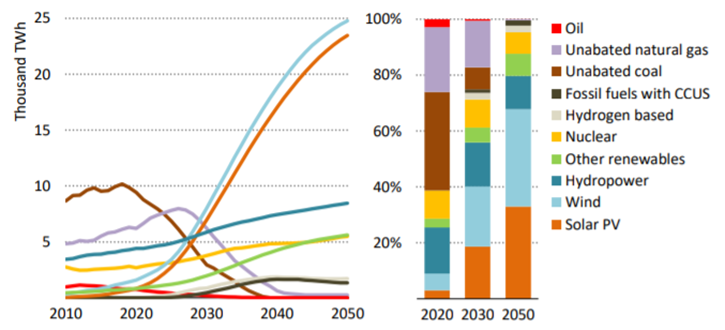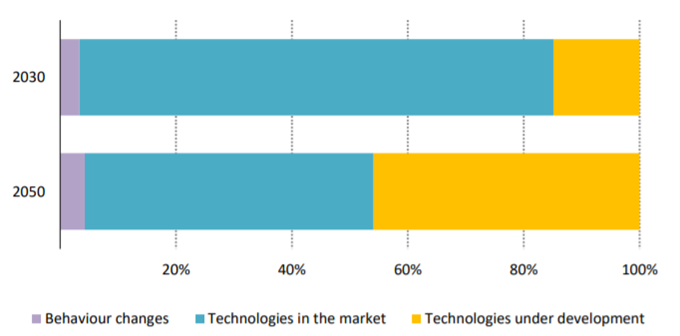IEA: Net-zero by 2050 “narrow but still achievable”
The International Energy Agency’s (IEA) recent Roadmap for how the global energy sector can reach net-zero by 2050 warns the window for success is “narrow but still achievable”. It lays down some recommendations for the type of policy action that is urgently required if the world is to get there and its blunt realism about what must be done is confronting reading for all parts of the political spectrum.
The Roadmap’s release coincided with the Federal Government’s announcement to build a gas-fired power station in the Hunter Valley. This provoked heightened commentary about the Roadmap and whether this decision was consistent with its policy recommendations.
Here we take a closer look at these policy recommendations and what it might mean for the energy sector in Australia.
Background
The IEA’s Roadmap has been produced in the lead up to the 26th Conference of the Parties (COP26) and aims to motivate countries to increase their level of policy action. It raises concern that the current “gap between rhetoric and action” is too great and must close quickly if the world is to have a reasonable chance of becoming net-zero by 2050. To corroborate this statement, the report models two scenarios:
- The IEA Stated Policies Scenarios (STEPS), which only takes into account the emissions reduction policies of countries that are legislated. Under this scenario, the IEA concludes that “reductions across all sectors fall far short of what is required for net-zero emissions in 2050”. This is mostly due to growing energy demand in emerging markets and would see a temperature rise of around 2.7C by 2100.
- The Announced Pledges Case (APC) assumes all announced net-zero pledges are met on time. Under this scenario, the IEA concludes that “existing net zero pledges, even if delivered in full, fall well short of what is necessary to reach global net-zero emissions by 2050”. While it achieves greater reductions compared to STEPS, in 2050 the world would still be emitting 22 billion tonnes of carbon dioxide a year[1], leading to a temperature rise of around 2.1c by 2100.
In light of these two conclusions, the IEA presents its Net-Zero Emissions by 2050 Scenario, which models the policy action required for the global energy sector to transition in time in a manner that is just, cost-efficient and has “social acceptance”. It places the onus on advanced economies, like Australia, to drive this change and support developing economies in doing the same. So, what are the policy actions that the IEA wants to see?
Large-scale investment in renewable generation
The IEA’s Net-Zero Scenario will require renewable energy to constitute around 90 per cent of global electricity generation, and nearly 70 per cent of total energy supply, by 2050. This means 630GW of solar PV and 390GW of wind added annually by 2030. To give some scale, the IEA states meeting this solar target “is equivalent to installing the world’s largest solar park roughly every day”. Meeting these targets will necessitate other changes too, with the Roadmap recommending advanced economies phase out their “least efficient” coal plants by 2030 and to close or retrofit with carbon capture and storage all remaining coal plants by 2040.
If Australia’s rapidly changing electricity generation mix is a microcosm of what is to come, then significant challenges await. The IEA is not in denial about this and does acknowledge that meeting these targets will have “important implications for the design of electricity markets”, but whether it fully appreciates the scale and political dynamics of these implications is less clear. The Roadmap does not go into any real detail about how to balance reliability with affordability when actioning such investments. Already, in Australia, the mass influx of solar and wind has precipitated contentious rule changes to manage system security, while debates about affordability have been at the political forefront. The IEA’s estimation that “total annual energy investment surges to US$5 trillion by 2030” to reach these targets will only further enliven these debates.
Figure 1: Global electricity generation by source in the NZE

The role of nuclear energy
As illustrated in the figure above, the IEA believes nuclear power will make a “significant contribution” to net-zero by 2050. Even though it will constitute less than 10 per cent of total electricity generation, this implies it will need to nearly double from now until 2050. This will entail adding an annual global nuclear capacity of 17GW until 2030 and then 24GW between 2031 and 2050. Getting there will ultimately require governments to make investment decisions now, given the pace of nuclear power construction.
The IEA does not make clear how it reconciles the expansion of nuclear power with its criteria to produce socially accepted outcomes. This tension is particularly acute in Australia where nuclear generation is prohibited through legislation and political debates about whether to repeal this prohibition have repeatedly fallen into the quagmire of partisan politics. What the IEA does claim though is any indecision will prove costly: failure to invest in controversial nuclear power and carbon capture and storage will result in an estimated global “additional cost of electricity to consumers between 2021 and 2050 [of] USD 260 billion”.
Carbon capture, utilisation and storage (CCUS)
Under the Net Zero Scenario, while fossil fuels drop dramatically, they still represent slightly over 20 per cent of total energy supply in 2050. For this reason, the IEA sees CCUS as playing a critical role, especially for sectors like aviation and cement manufacturing where alternative low-emissions technology options are scarce. For these sectors, the Roadmap says that in every month from 2030 onwards, 10 heavy industrial plants must be equipped with CCUS. CCUS will also be necessary to capture the emissions from the remaining coal-fired plants, as well as gas-fired plants that are built to provide dispatchable electricity.
Not dissimilar to the nuclear dilemma, this will require governments to make investment decisions now, both in research and development and deployment if CCUS technology is to be ready in time. Such decisions will, and have already proven to be, contentious because it is seen by some as investing in an unproven technology that will only extend the life of fossil fuels, rather than contain them. The IEA, for its part, sees no alternative: it concludes that a failure to develop CCUS for fossil fuels will mean nearly US$15 trillion of additional investment in wind, solar and electrolyser capacity would be required, and ultimately, “achieving net-zero emissions by 2050 would be very much harder”.
Therefore, despite the heightened commentary, the Roadmap does not prohibit gas-fired generation. To the contrary, it concludes that natural gas-fired generation will be “an important part of electricity supply through to 2050” on the caveat that CCUS “is deployed soon and on a large scale”.
Figure 2: Annual emissions savings in the net zero pathway. CCUS is considered a technology under development

Just transition
Apart from the technology considerations, the IEA frames its Roadmap by emphasising that “energy transitions have to take account of the social and economic impacts on individuals and communities, and treat people as active participants”. The need for a just transition is being increasingly recognised around the world, including in Australia. How that can best be achieved is something the Australian Energy Council and its members are already assessing and planning for.
Conclusion
The Roadmap’s suggested trio of investment in renewable generation, nuclear energy, and CCUS is unlikely to please either end of the political spectrum and ultimately means very difficult decisions lay ahead for governments fully committed to a net-zero by 2050 vision. If there is one clear takeaway, it is all technologies, including ones that are untested and controversial in Australia, are going to need to be part of this global journey.
[1] For comparison, global carbon emissions in 2019 were nearly 37 billion tonnes.
Related Analysis
2025 Election: A tale of two campaigns
The election has been called and the campaigning has started in earnest. With both major parties proposing a markedly different path to deliver the energy transition and to reach net zero, we take a look at what sits beneath the big headlines and analyse how the current Labor Government is tracking towards its targets, and how a potential future Coalition Government might deliver on their commitments.
International Energy Summit: The State of the Global Energy Transition
Australian Energy Council CEO Louisa Kinnear and the Energy Networks Australia CEO and Chair, Dom van den Berg and John Cleland recently attended the International Electricity Summit. Held every 18 months, the Summit brings together leaders from across the globe to share updates on energy markets around the world and the opportunities and challenges being faced as the world collectively transitions to net zero. We take a look at what was discussed.
Great British Energy – The UK’s new state-owned energy company
Last week’s UK election saw the Labour Party return to government after 14 years in opposition. Their emphatic win – the largest majority in a quarter of a century - delivered a mandate to implement their party manifesto, including a promise to set up Great British Energy (GB Energy), a publicly-owned and independently-run energy company which aims to deliver cheaper energy bills and cleaner power. So what is GB Energy and how will it work? We take a closer look.
Send an email with your question or comment, and include your name and a short message and we'll get back to you shortly.



